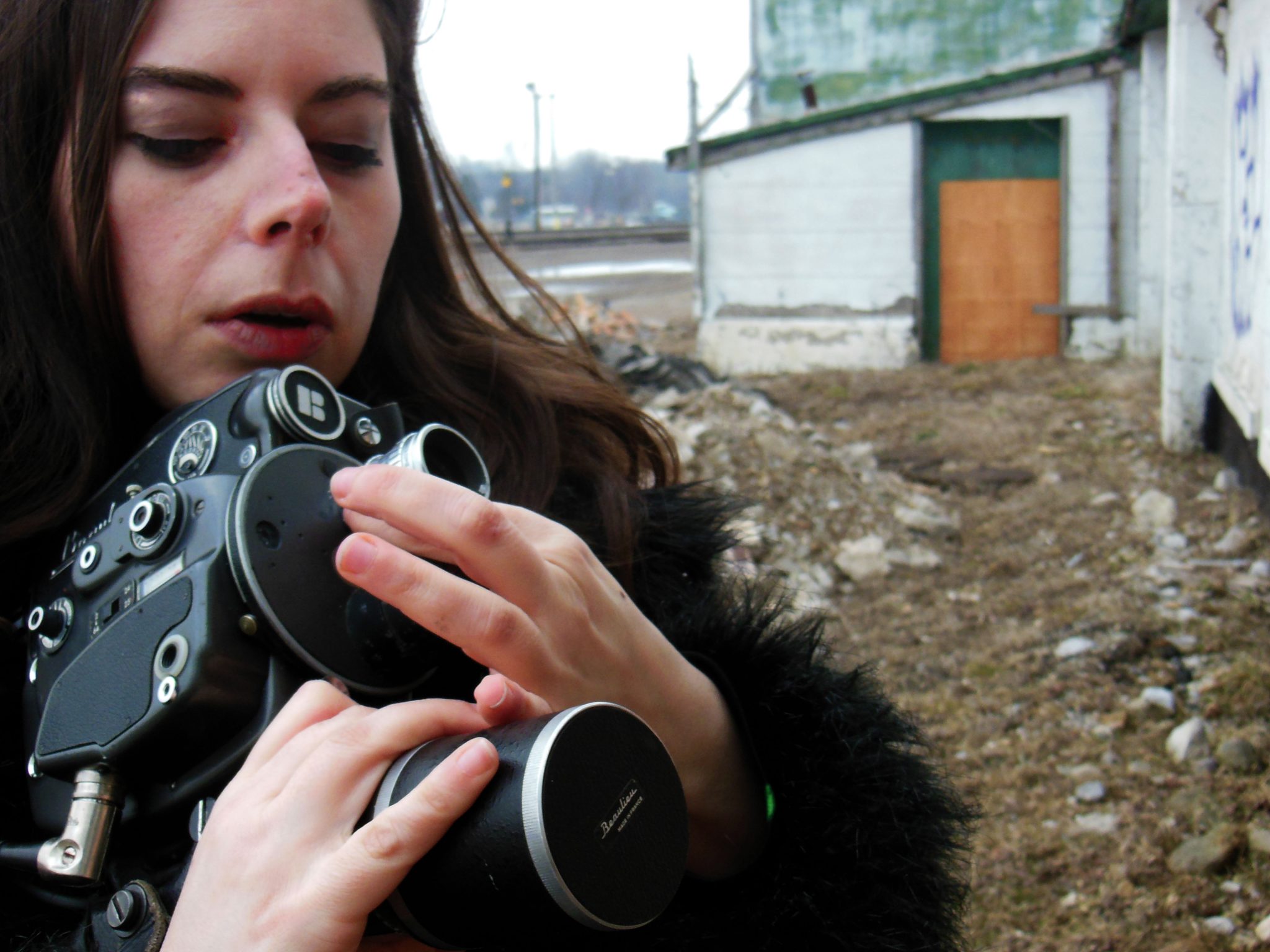
‘Christine Lucy Latimer is a mother of lost medias. As an artist, she is drawn to the forgotten, the mouldy trash, the refused. How tenderly she touches these pictures again, along with the shadowy figures they contain, in order to begin the work of restoring them to view. In her practice, this means straining the often fragile, even falling-apart originals, through a series of analog/digital trespassings. Her animating question is not the same as an archivist, who works to retrieve and restore inside the dystopian frame of “the original.” Instead, this artist spellcasts her found footage – whether home movies, peep shows or late night TV grabs — into something else. Like “art” for instance.
‘Christine’s media translations bear the marks of her looking, which means that the footage has been necessarily transformed, touched by something in the present, and turned beneath that touch into something newly alive. Her meticulous reframings offer us a reflection on how pictures survive, and what we do with them in order to ensure their survival.
‘As my pal Mike told me, more than once, the reason great books are so great is not because they possess “universal values” but because they can be reinvented, over and over again, as each reader uncovers them in their singularity. They are available for radical reinterpretation, and because they are able to change, they endure. Chris Marker from San Soleil: “We rewrite memory much as history is rewritten. How can one remember thirst?”
‘A surreal moment in New York’s Collective for Living Cinema. It’s an afternoon screening and the room is jammed, strangely enough. Half the program belongs to Abigail Child who is showing some of her Is This What You Were Born For? masterworks, still fresh then, newly minted from the lab. Some feature kinetic, jazz-inspired reworkings of original “home movie” materials, and in the required question and answer period, fringe godfather Jonas Mekas asks what happened to the original footage that Abigail used. What? It seems he was less interested in the artist’s bravura collage, than the throwaway detritus that Abigail had wondrously transformed. I could feel the generational faultlines and mutual outrage, along with the sense that every frame was a line in the sand, every cut had to be argued and won over. The exchange was quintessential New York fringe: erudite and hostile.
‘The godfather, so often benevolent and easygoing, spent much of his life trying to preserve the most ephemeral of film practices, so his protests might be understood as a cautionary tale. What he failed to reckon with was that nearly every image drives towards disappearance. It’s the natural lean, the most usual thing. Sure Wittgenstein could hum an entire symphony after hearing it once, but most of my Netflix-addicted pals struggle to offer even the barest hint of a plot after a night’s viewing. As if pictures are vanishing even more quickly than they appear. It’s like Virilio’s riff on hyper speed: where you arrive before leaving. Pictures are not only arriving more quickly, they are disappearing at an even greater rate. The rapid succession of pictures that nearly every movie provides takes us through this process. Movies are a demonstration of death “at work,” of disappearance, forgetting and erasure. Movies offer us the joy, the beauty, the savouring of moments that mercifully will never happen again.
‘Christine Lucy Latimer’s work, mostly short and silent, suggests that the only way to look is to look again, to see something for the second time. And like Abigail before her, and how many others, she is offering us her own version of disappearance, along with her own views and transformations, her own necessary reframings.
‘But wait, what about the work’s “content?” Shortly after we met Christine pronounced herself “a formalist” and I wondered if that was the kind of thing that could be said out loud. But of course the fragments she rescues in her work are not incidental. For instance, there is a pronounced interest in the display of female bodies, both Ghostmeat and Format rework peep shows. A Fight to the Finish display nearly naked male boxers glitching up a love clinch, The Pool offers a quartet of men in bathing suits, performing masculinity in a viscous, toffee-coloured pool that clings to everything. But mostly the pictures are “abstract,” as if the artist was looking too closely, the eye pressed right up against its subject, until it dissolves in a wash of light and line and colour. Whether it’s Nationtime’s slowed firework eruption, the traffic glaze of The Bridge View, the pinball wizardry of Fraction Refrain, or the soft Oedipal revenge of Lines Fixial (a conjoining and reworking of a pair of Norman McLaren/Evelyn Lambart films), the artist offers us geometries freed from the burden of strict representation.’ — Mike Hoolboom
____
Stills
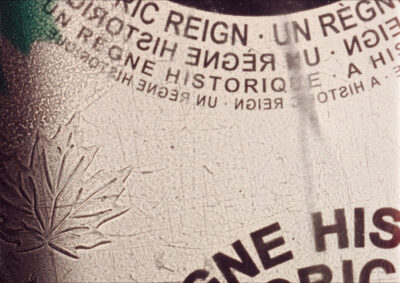
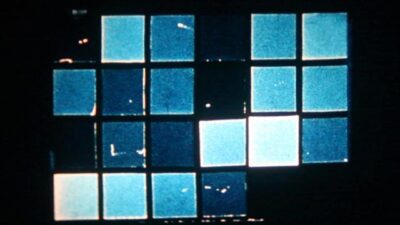


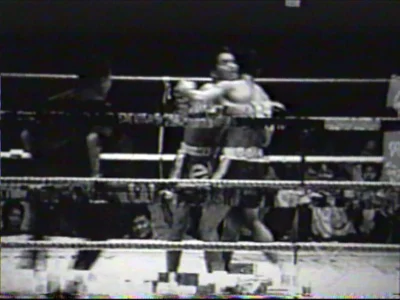
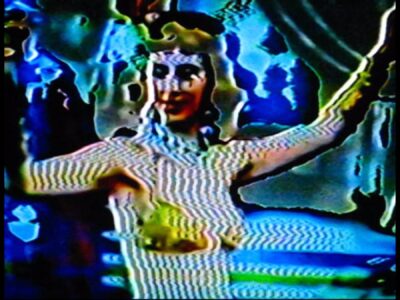


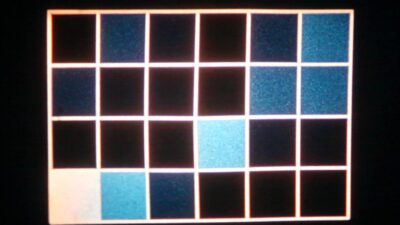

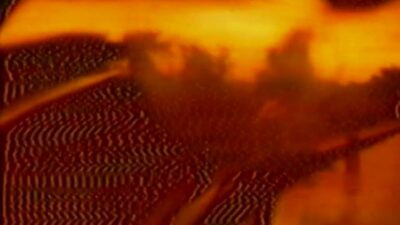



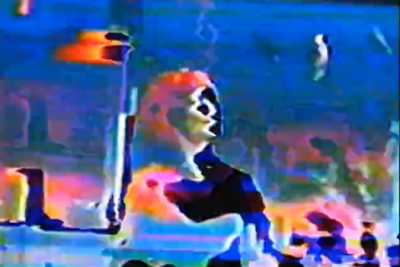

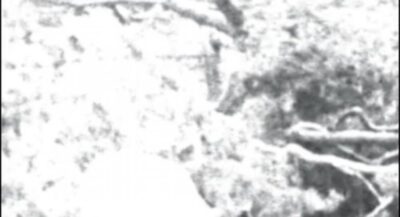

____
Further
Christine Lucy Latimer @ IMDb
Christine Lucy Latimer @ Vimeo
Book: ‘Christine Lucy Latimer: Media Archaeologist’
CLL @ MUBI
Fragile Systems: Films and Videos by Christine Lucy Latimer
CLL @ Underground Film Journal
CLL @ Letterboxd
____
Extras
Christine Lucy Latimer INTERVIEW
Man Made Hill – One False Second (Music video by Christine Lucy Latimer)
Stephen Broomer Wild Currents, for Christine Lucy Latimer (2015)
____
Interview
from BlackFlash
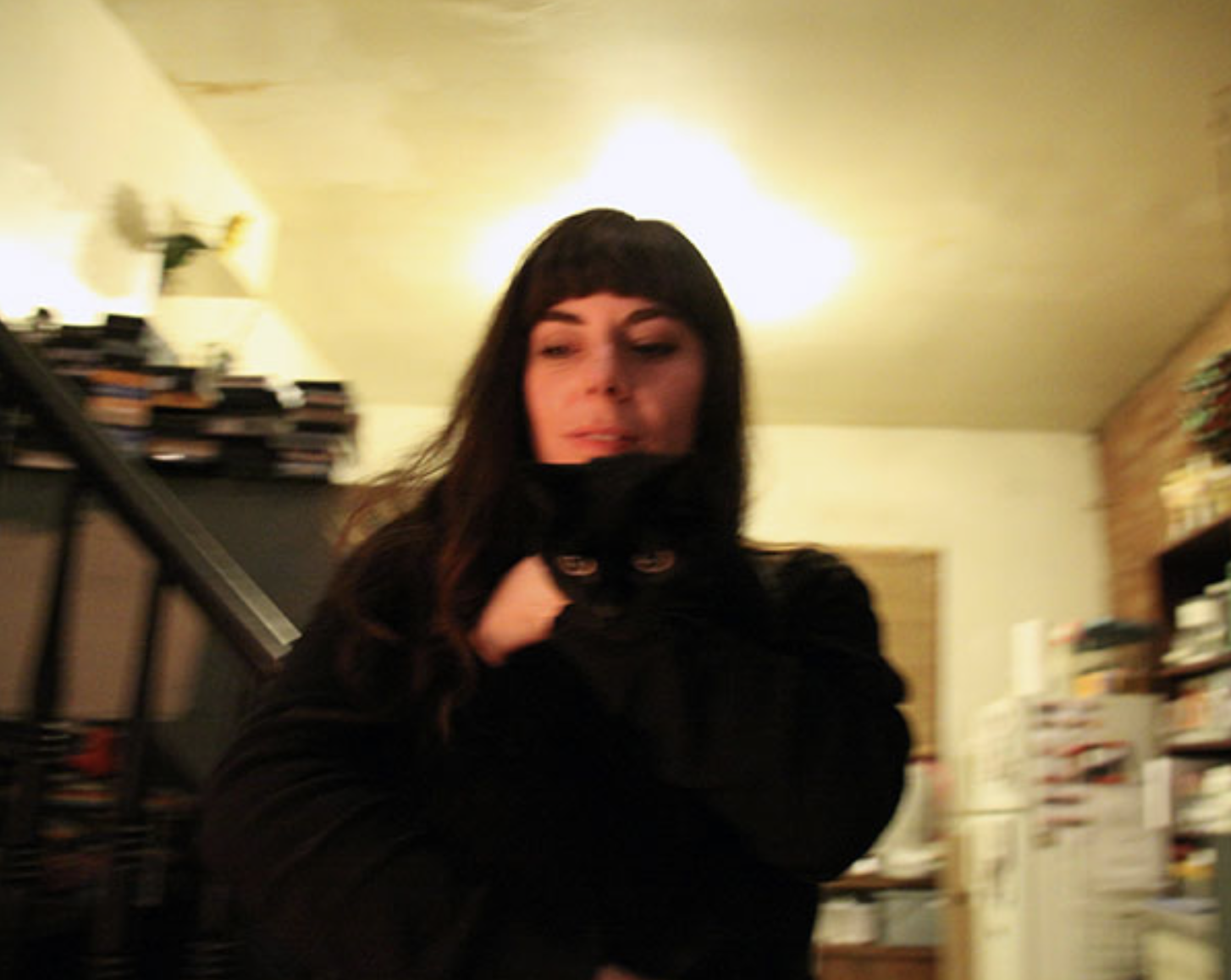
Leslie Supnet: Can you discuss the role media hybridity plays in your work?
Christine Lucy Latimer: My work manifests from a fascination with moving-image tools and their evolution through various zeitgeists. Using the detritus from these histories (broken gear, found/abandoned videotapes and small-gauge home movies) as art-making material, I strive to comment on issues of authorship, relevance and obsolescence in lens-based media. I am curious to explore the particularities within a given imaging technology, and what happens when it is deemed no longer commercially relevant.
Therefore, my practice often employs the combining of multiple media formats into one hybrid image. I enter into diverse states-of-play with different processes, including multi-generational video transfers, lens/projection interruption and the daisy-chaining of several live technologies. Through modes of salvage and reconstitution, the unique artifacts of these historic mediums squish together to create image-scapes of indeterminate time/place origin.
How has time and place influenced your art practice?
My artist mother, avid film-and-television-watching father, and generally westernized, middle-class suburban upbringing (just on the outskirts of Toronto) were all quite important to the evolution of my art practice.
Toronto in the late 1990s was also a huge source of influence. At the time (as a double-majoring Photography and Integrated Media student at the Ontario College of Art and Design), a tacit fluency with digital imaging technologies had not yet emerged in the postsecondary institution. Training in lens-based crafts that preceded the digital were much more on the forefront of my education. I was taught archival film and paper processes in my photography classes, learned celluloid-based filmmaking, and worked with analog video using broadcast-quality Beta SP cameras.
The medium-specific leanings at OCAD were quite pointed when I was a student there. Many of my instructors were moving-image artists that became active in Toronto in the 1970s and ’80s, and they either identified strictly as experimental filmmakers OR video artists. At the time, experimental film and video art (in Toronto at least), largely existed as separate camps that prioritized very different things. There was a clear divide, with divergent infrastructures towards making, distribution, representation and exhibition.
The ways in which time-based making was differentiated in the arts institution were baffling to me, and this confusion increased with my expanding exposure to experimental film and video art. I grew up as any suburban, westernized middle-class kid did in the 1990s—going to the cinema and watching VHS tapes—with one foot planted squarely on either side of the film/video fence. The similarities among these forms were magical, because to me, they symbolized an obvious space of evolution and democratization. Film and video spooled backwards and forwards, transporting through time in the same way. They also were both made out of metal (silver emulsion and oxide).
I realized quite early on in my arts education that I was drawn to mediums that were uniquely bound to the industrial and electronic revolutions of the 20th century. I became curious as to how I could unify the mediums artists used to make moving images in a gesture of revolt towards the strange divisions I encountered. I began making work that hybridized film and video on one image plane, employing various transfer processes between mediums to try and eliminate the visual signifiers that would detail where film ends and video begins. Obviously, the nature of this sort of hybridity is quite era-specific, as definitions of ‘filmmaking’ were poised to change soon after, with the wide consumer emergence of digital lens-based technologies.
Artifacts, both digital and analog, create otherworldly environments in your works, such as in Mosaic, 2002. Was this your first piece? How did it come about?
Mosaic is my first official film, in that it’s the first project I made after finishing my schooling and striking out on my own as an artist. It’s also one of the first projects I made that incorporated digital image elements.
In my final years of school, broadcast television experienced a change with the arrival of digital cable. The infrastructure of over-air broadcast was so vast, while digital broadcast was much more a novelty—something that consumers weren’t yet convinced of the value of.
In 2001, I was offered 3 free months of digital cable, and the promise of hundreds of ‘specialty channels’ which were, at the time, more like half-baked nether-channels struggling for content to fill a programming day. I have always been an avid television-watcher, and this new form of television, replete with hundreds of totally crazy “geared to lifestyle” channels, sent me into a vortex of sleepless nights and blank staring. It wasn’t simply the burgeoning, desperate clangings of a new medium in its emergence; it was also the delivery system, the digital image itself that was being broadcast.
At this stage, digital broadcast was highly unstable and prone to failure. It would vacillate endlessly between moments of representation and abstraction—a chunky coloured square array could become an episode of “Extreme Fishing,” while a late-night “Turner Classic” movie could became an achromatic vibrating houndstooth pattern. These distortions of signal were not the snowy screens of broadcast television that I grew up with, but something else that represented that struggle of the new—an image trying to wrestle against its own technological limitations in order to emerge.
I began to record hours of these distorted signals onto VHS tape. I was quite preoccupied, because it was all so beautiful, and it was constantly changing. One particular day, there was a Muai Thai fight on one of these channels that was producing some terrific visual distortion, but was also simultaneously distorting the ways in which I understood the fight. The distortion removed any concept of winning or losing, prioritizing simply the placement of engaged bodies, wrestling to find their next position. I loved the unlikeliness of this footage, and that I could capture these fledgling digital distortions on a tape media that the digital revolution itself would soon render obsolete. I wanted to collapse further history into this image, to describe the newness and preciousness of that moment in time with a traditionally more precious moving image medium. So, I got a local film processing lab to transfer my VHS footage of a digitally scrambled cable TV boxing match onto B&W 16mm film.
How do chance and improvisation inform your moving image practice?
Whatever I am working on is usually guided by the images or technologies I have most recently found to play with. I am constantly on the hunt for abandoned media and gear, some of which I have to either fix or teach myself to use, which allows for several elements of chance in my process.
My ideas are always about generating unpredictable, unexpected results from the unlikely marriage of formats or processes. I tend to work in bursts, finishing projects very quickly.
Each project is highly mysterious, prone to failure, and inconceivably impossible to picture until it’s actually finished.
_____________
18 of Christine Lucy Latimer’s films
_____________
Fraction Refrain (for Loeser, Evans & Snow) (2016)
‘An auto-mechanized directive for mapping a microcosmic landscape. Using cut-glass filters on a broken VHS camera, I traverse the terrain of a vintage pinball machine using mechanical movements reminiscent of Michael Snow’s La Region Centrale. (Dedicated to Mark Loeser, Justin Evans and Michael Snow).’ — CLL
_____________
Still Feeling Blue About Colour Separation (2015)
‘This film rephotographs over 200 internet-sourced images of ‘Macbeth ColorChecker’ cards on to super-8mm cyanotype emulsion. Macbeth Cards (precision tools in colour film processing), were a popular accessory for small-gauge Kodachrome filmmakers in the 1970’s. They have since been re-adopted by contemporary digital photographers, who use them to compare lighting scenarios on internet blogs and forums. Tracing the history of the colour calibration card through many lenses, I effectively remove all colours, save one.’ — CLL
__________
C2013 (2014)
‘A durational feedback-variation study using a found VHS banjo lesson cycled through a (mostly broken) betamax deck. A distorted hearkening to the various ‘lessons’ of youth combines with inquiries surrounding learning, training and the mastery of a medium. The project’s length and pacing simulates that of a childhood music lesson: 40 minutes that feel like a lifetime. (The project title is a notation taken from banjo music tablature, denoting that a C chord is played with fingers on the 2nd, open, 1st and 3rd frets of the instrument).
‘**NOTE – this project is an installation video, meant for casual approaching and walking away from.’ — CLL
_____________
Physics and Metaphysics in Modern Photography (2014)
‘This hybrid project uses a cell-phone to document a series of colour plate advertisements from The 1957 Photographer’s Almanac. The footage is then transferred to 16mm film, presenting the advertised technologies of 1957 (coincidentally, the first year a digital image was ever generated) through simultaneous analog and digital lenses. History is collapsed in a comment on the changing terminologies of lens-based practice.’ — CLL
_____________
Jane’s Birthday (2013)
‘A simultaneous low-definition/ high-definition spastic depiction of an attempted journey to the beach on my sister’s birthday. Windshield wipers punctuate and jump-cut our rapid movement through white-knuckle moments of abstraction.’ — CLL
_____________
Lines Postfixal (2013)
‘Two found companion 16mm film prints (salvaged from the garbage at the National Film Board of Canada) are simultaneously reunited in a coda to their original composition. The image is worked in multiple generations through betamax and vhs tape decks to weave threads of video artifact into the celluloid fabric.’ — CLL
_____________
Nationtime (2013)
‘Cell-phone video footage of exploding fireworks is processed and extended through a series of VHS feedback loops. What was once a momentary blast becomes drawn out in time, emphasizing the beauty of pyrotechnic light, while juxtaposing analog and digital video artifacts.’ — CLL
____________
The Pool (2012)
‘1950’s 16mm swimmers dive unknowingly into video-infested waters. A hybrid project created with found 16mm film projected through a broken glass plate, captured by two daisy-chained video cameras (one analog, one digital) and run through a Vidiffektor (an analog video signal attenuator custom-built by James Schidlowsky).’ — CLL
____________
The Magik Iffektor (2011)
‘A video that electronically twists the fates of witches, monkeys, apparitions and conjoined bald men. Created with found VHS footage.’ — CLL
________
Fruit Flies (2010)
‘This film seals under perforated 16mm splicing tape all of the fruit flies that drowned in the vinegar trap on my kitchen counter last summer.’ — CLL
________
Format (2010)
‘In one long take, I shoot super 8 footage of a found nudie film that is projected both on the wall, and within the LCD screen of a digital video camera. A film of a film of a video of a film ensues.’ — CLL
______
Focus (2009)
‘Using glue and 16mm splicing tape, I place over 1500 individual super 8 film frames from a decimated home movie one-by-one on to clear 16mm film. The resulting floating film-within-a-film becomes a jarring landscape that prioritizes the structure of the super 8 frame over its photographic contents.’ — CLL
_____________
A Fight to the Finish (2009)
‘A Fight to the Finish is a chaotic duel between the film and video depictions of a violent animal encounter. A project combining found 8mm film and pixelvision.’ — CLL
_____________
Just Beyond the Screen: The Universe, as We Know It, Is Ending (2009)
‘This film and video hybrid depicts a rainbow digital apocalypse looming directly outside a floating cinema entrance-way.’ — CLL
_____________
Over {Past:Future} Sight (2008)
‘This film uses video footage captured from the surgeon’s microscope during my father’s laser eye surgery. The footage is transferred to 16mm colour film negative, printed, edge-fogged and brown-toned. Clinical and impersonal video documentation transforms into an intimate hand-made celluloid exchange with my father’s watchful yet un-watching eye.’ — CLL
_____________
The Bridge View (2005)
‘“Road-Watch” television footage of Toronto highways (from the local stock-market information channel) is processed through a series of slow-shutter VHS feedback loops. A cinematic surveillance depicting traffic absent of time/place designations.’ — CLL
______________
Ghostmeat (2003)
‘This hybrid film/video uses a toy pixelvision camera to document a dual-projection of a found 16mm film and a liquid light array. The 16mm film was salvaged from a mutoscope, a turn-of-the-century device outfitted with an eyepiece in a (sometimes coin-operated) mechanical cabinet that enables a viewer to have a private film-watching experience. The footage, shot in the home, is of a late-1940’s woman undressing slowly for the camera (and its operator). Between found film, the perpetual movement of abstract light, the degraded pixelvision image and the particularities of documented 1940’s female sexuality, these juxtaposed projections move through a panoply of interpretations surrounding resurrection and decay.’ — CLL
_____
Mosaic (2003)
‘VHS footage of a digitally scrambled cable TV kickboxing fight is transferred to 16mm B & W film negative and printed by hand. Digital interference foregrounds and destroys the representational action, creating a rhythmic, abstract tonal landscape.’ — CLL
*
p.s. Hey. If anyone reading this happens to be in Toronto, there’s an event there tomorrow night called Fragile Systems: Films and Videos by Christine Lucy Latimer where the vast majority of her short films and videos will be shown. Use the link for more information. ** malcolm, Hey, Malcolm. I’m happy he pleased your ears. I hope you get to have that emotional epiphany on your shoot. It was kind of shocking to feel happening. I’m not a person who’s given to crying almost ever. If you remember the car scene in PGL, which is my favorite scene, that’s when it happened. The performers just beyond nailed it on the first take, and I was blubbering. Afterwards I was hugging them and thanking them, and they were really surprised they’d been so good. It’s very interesting to me on shoots how the actors often don’t really know when they’re being amazing. We’ll be lucky here in Paris to get 15 minutes of piddly snowfall the whole winter. When I first moved to Paris, we’d get a few snow dumps over the season, but it’s too warm here now. It’s sad for me because, growing up in coldness-defying LA, snow is super romantic to me. Any highlights re: you today? ** Dominik, Hi!!! Yeah, right? I never think to eat pomegranates, and I really should. My friend the artist Charles Ray decided he wanted to figure out the perfect joke as an art piece, and he spent about two years trying to figure it out and telling his friends jokes and asking if they were perfect, and they never were, as far as we could tell, and he eventually gave up. There are a fair number of those ‘Nirvana fans’ here in Paris. Love deciding to become everyone’s groupie, G. ** _Black_Acrylic, Yeah, the overlooked genius archetype is very magnetising. I suppose this blog is often trying to unearth them. I watched a little of the French team’s match, and, yeah, Mbappe is a joy. I was going to ask you why the World Cup wasn’t being held in the country of the previous year’s winning team, and then I realised I was confusing the World Cup with Eurovision, ha ha. ** Steve Erickson, I saw Nan around in those days, and I was acquainted with some of her photographed friends, but I didn’t get to know her until some years later. Everyone, Steve has reviewed Laura Poitras’ documentary on Nan Goldin ALL THE BEAUTY AND THE BLOODSHED, which I, for one, am dying to see, here. ** David Ehrenstein, NC was amazingly ahead of his time. ** Brian, Hi, Brian! Virtually every time I get really stressed out, money is always heavily involved in the reason. Which is no doubt a big reason why I’m an anarchist. Not that that helps in a practical way. ‘What you think and what you irrationally feel often don’t square very easily’: Boy, is that true. It’s also like the first sentence in a Dickens novel. Maybe. I suppose you’ve tried to just think of food as fuel and nothing else? I kind of think of food as that. I eat the same boring thing every day, and I don’t care one bit. I like your Halloween/Thanksgiving hybrid event. Wait, it’s Thanksgiving today, I think. Do you have a big family turkey-centric ‘feast’ set for today, and, if so, I’m assuming you are dreading the feast part. My non-Thanksgiving will involve having to go to an art opening this evening to schmooze and nudge the show’s curator who promised money for our film and hasn’t delivered yet nerve-wrackingly. Happy happy hopefully! ** Ahh! Licks James, I’m trying to guess who James is. I agree with everything you wrote. ** Autumn Glint, Yeah, they do Black Friday here, and I really should use it to buy the Switch I’ve been procrastinating about buying for forever, but I probably won’t. As for you, buy the farm! ** Okay. I feel fairly safe in assuming that most of you are not familiar with the exciting films and videos of Christine Lucy Latimer, and that explains why I felt it was valuable to make the introduction. Christine, meet the blog readers. Blog readers, meet Christine. See you tomorrow.




 Now available in North America
Now available in North America 
Hi!!
That’s dedication – spending two years trying to figure out the perfect joke. Do you think “perfection” exists?
Nobody can accuse love of only going for a certain type, haha! Love hardly believing the email notifying him that the body (but not yet the head) of his BJD has just shipped, Od.
You’re right to assume that I’m unfamiliar with the work of Christine Lucy Latimer, but I do enjoy what’s going on in her uncannily affecting films. Dunno if there’s a problem with the sound on my computer? I appreciate the visuals here anyway.
Hey Dennis.
The films of CLL are amazing! I watched a whole bunch of the ones above today and will be devouring the rest tomorrow. So good. Every one I watched, I kept thinking ‘now this is my favourite.’ What a body of work. I’m in total awe. The Pool and Nationtime…wow. Thanks for again introducing me to another wonderful filmmaker.
Greetings from Ostend. I’m having a lovely time, feeling fully focused on my novella and enjoying every minute of it. This is the most seriously I’ve ever worked on one of my own projects and this time here has been a real eye-opener. I’ve edited then walked along the beach then edited then eaten and it’s been a joy. God knows why I love this place so much, but I do. Yes, to statues on the beach, I think they have a semi-regular art fair and artists sometimes use the beach for their work. There’s a newish one that I quite like, mostly because it gets almost submerged when the tide’s high.
How are you? Did you get some more people to work on Room Temperature? How’s casting?
Hope all’s good with you and Friday treats you royally (meaning I hope it treats you well, not that it makes paparazzi follow you about everywhere).
Puzzling yet ultimately enjoyable love,
Jamie
WATCH THE PROCRASTINATION DENNIS, GET THE SWITCH… OR EVEN A SWATCH…
TALKING ON THE SUBJECT OF PROCRASTINATION THERE WAS A NEWS BULLETIN ON FEATURING LOTS OF DEAD PEOPLE AND I FELT THE URGE TO ‘JACK’ RIGHT THERE IN FRONT OF THE TV… I FOUND IT THRILLING ALTHOUGH I HAVE TO BE CAREFUL YOU KNOW…. AS MI6 AND THE CIA ARE SOMETIMES LISTENING IN AND EXTRA TERRESTRIAL INTELLIGENCE, GOD OF THE OLD TESTAMENT, CHRIST THE REDEEMER….. THE ONE WITH THE ANTLERS,,,,, MOM, ETC….
ANYWAY ENJOY BLACKENING THIS FRIDAY DENNIS I CERTAINLY WILL
Hey Dennis,
Weird-positives are always eye openers. They kinda make me cock my head like a confused dog, but then I’m like “Ahhhh, shit, yeah.” My therapy was online this week, so I got to see myself in the little box on screen, looking like a confused student whilst my hot daddy therapist was explaining things to me. Maybe I should have told him about the alternative Dom and Jeffery in the tree, doing things they shouldn’t be. See what he’d make of that. LOL. I did check up on my review last week where I suddenly came to life with the psych, when after glum meeting, I suddenly went on about my life being an episodic soap opera with full season plot through-line… thankfully this went by un-noted.
Ooh, the film sounds exciting! I can’t wait for more progress. I ended up being an extra in a film this year, a really cool indie film that’s still being filmed by an awesome guy called Layke Anderson. I’d kinda known of him before, but we got put in actual touch by John Cameron Mitchell, who I ended up going on a random walk-around London with during the second Lockdown when he was here filming “Sandman”.
I think the ghost of Dahmer has taken over Minnie, she’s currently chewing off the face of a plushy. I think she needs a walk. Ha.
Much love from London. Hugs.
Dom
holy shit!! i have no free time for the next 2 days, but on sunday i am beyond excited to watch every single one of these videos. the story + the stills are incredible. exactly the kind of thing i am into. and it’s canadian content!! love. reminds me of this tumblr blog i love, mamre. i don’t know if you’re into tumblr but if you are (or even if you aren’t), check mamre out on there. huge source of visual inspiration to me.
highlights for the day are practicing making fake wounds out of liquid latex again, i feel like i’ve gotten pretty good at them pretty quickly, and the fact that today is the one year anniversary of the first time i watched the before trilogy. i love those movies so much. i’m wearing my shirt i made with a section from the screenplay of before sunset on it to celebrate. and i had a really nice uber driver this morning that subscribed to my youtube channel.
my favourite thing about snow is when it’s so bad that i get to stay home, rather than go to work (or school when i was younger. i think it was february 2017 where i only had 5 days of school the entire month because the snow was that bad everyday). this year im hoping for some in february or march so that it looks like christmas when we film the short, but other than that, it’s never something i look forward to. i get how it seems romantic when you aren’t used to it though.
i do remember the car scene in PGL and i do remember it being quite great, that whole movie is so beautiful and tender, everytime i think about it i find myself liking it more, i’ll have to rewatch soon.
if you are on tumblr, my blog there is june16th1994 (after the day jesse and celine meet in before sunrise), it’s a little messy at times but i post a lot of tape stills and things like that. probably my favourite social media
did you celebrate thanksgiving today? not sure how big it is in france, or if it’s on a different day like it is here in canada. see you tomorrow!
Hey, Dennis,
Today was very busy, so I’ll have to save a closer look at this post for this weekend, but a quick skim suggests it has great things in store for me when I do. Ditto on money. And anarchy, I suppose. Or Marx, possibly. Something other than this. I’m no Dickens, though I’m sure he would have concurred with the sentiment, of course. Food as fuel is one angle I’ve tried, and it hasn’t quite worked. Nor has the appeal to my senses (think of all the wonderful things you have yet to experience, etc.), nor the quite urgent appeal to my health, although that one might finally push me into change, because I’m almost as pathological about the prospect of illness as I am about the experience of food. It really is just a matter of very long habit, and habits can be overcome, but it’s so difficult to erode the knee-jerk anxiety and physiological revulsion that overtakes me as soon as I’m faced directly with the prospect of eating anything outside of my pitifully small and woefully insufficient diet. I need to be trying much harder, though. Every day, as intimidating as that seems. You were right both on the big family feast and on my dread: I never eat, and I always feel ashamed sitting at the table. This year was no exception. Perhaps next year will be different. Otherwise, the company was pleasant, and it’s nice to be home, and late at night I saw a movie with my brother and a mutual friend of ours, so a mostly successful Thanksgiving. Yours had a substantially greater stress factor, judging by your description. Did the schmoozing and nudging go well? Happy happy hopefully indeed…